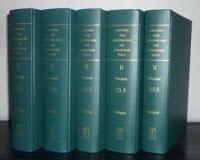 Samuel Sandmel's invocation of the problems of "parallelomania" in 1961 has become legendary in the field, to the point of truism, misrepresentation and cliché. It even has its own Wikipedia page.
Samuel Sandmel's invocation of the problems of "parallelomania" in 1961 has become legendary in the field, to the point of truism, misrepresentation and cliché. It even has its own Wikipedia page.Much less well known is sourceomania. I heard it for the first time earlier this week. Nobody even quotes it. And up until I started tweeting about it this week, even Google did not seem to know the term ("Did you mean source romania?")!*
The term "sourceomania" was coined by Morton Scott Enslin in a little known article published posthumously in 1985, “Luke and Matthew: Compilers or Authors?” ANRW II.25.3 (1985): 2357-88. The article reflects on the scholarly inclination to see the evangelists more as archivists than as authors, and to default to hypothetical sources to explain variation at every turn. Enslin uses the term twice. I quoted the first use in yesterday's post. Here is the quotation in context:
In sum, it cannot be too strongly emphasized that the only support for this hypothetical Q, which so mysteriously completely vanished and of which no slightest mention is to be found in any of the Fathers, is the assumption that neither Matthew nor Luke could have been satisfied to use the other, had he known it, so meagerly. What that really means is that we could not have so done. It is easy to forget that none of these writings, which we prize so highly today, was "Holy Scripture" or "canonical" to the other writers. Obviously, both Matthew and Luke found Mark of great use, but neither hesitated to alter, shorten, or correct to a degree that a modern critic might weIl hesitate to follow. I cannot avoid the conclusion that these hypothetical sources which no one has ever seen -- be they Q or L or proto-Luke or M -- are simply the consequence of the very modern notion that one holy evangelist could not deliberately have altered or violated the writings of another. Thus these deviations, as notably Luke's flat contradiction of Mark's account of the Passion, with the Galilee chapter deftly avoided and the disciples remaining in Jerusalem awaiting their reception of the Spirit, are commonly explained as due to the utilization of a different source. Sourceomania, if I may so phrase it, is a disease from which many critics have suffered. The point to be remembered is that each of the evangelists was apparently dissatisfied with the work of his predecessors and thought he could do a better job. Else he would not have written. They were not joining with respected colleagues in contributing chapters for a Festschrift (2364; emphasis added).The second use of the term comes when Enslin is discussing Luke 9.51-6 (Samaritan Village):
To me the basic weakness in much source analysis is the assumption of the use of some different source every time one author alters or changes another. Luke corrects Matthew because he thinks Matthew incorrect, not because he chances to find a different version of the event in some source which he chances to have in his hand or in his memory. One of the fatal symptoms of what I have styled "sourceomania" is the inability to recognize the evangelists as authors who had ideas and were ready to express them. They did not conceive themselves as weighted down by the awesome responsibility of preserving unaltered a series of facts for future generations who would study them under the critical magnifying glass as contained in Holy Scripture (2374; emphasis added).Although Enslin himself does not provide a definition of the term, it seems pretty clear that his problem relates to the instinctive appeal to imagined sources in lieu of even considering the possibility that a given feature might come from the author of the work one is reading. If I might attempt a definition, it would go something like this:
Sourceomania: the unnecessary and obsessional evocation of sources to explain elements in a work at the expense of considering authorial creativity.
Perhaps that definition can be improved upon, but I think the gist of what Enslin is saying is clear. As a minimum sources person, I am of course more sympathetic to the point than my maximum sources friends will be, but as a descriptor of a feature that I have seen time after time in the literature, asserted as if self evident rather than carefully argued, I think it's pretty great.
--
* When I composed this draft yesterday, "sourceomania" returned no proper hits at all on Google. Now, as well as this blog, it has found a lovely example from a book by Finn Damgaard, Rewriting Peter as an Intertextual Character in the Canonical Gospels (Copenhagen International Seminar; Abingdon: Routledge, 2016): 2:
The "sourceomania" (the word is taken from Enslin. . .) that has characterized New Testament scholarship for so long has paradoxically minimized the most obvious sources, namely the canonical gospels themselves, with the result that important insight into early Christianity has been neglected.
